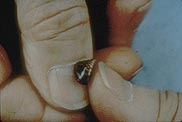Rivers
Habitat code: 415 Photo: KMD |
 Photo: KMD |
 Salmon Oncorhynchus sp. Photo: KMD |
Distribution and Habitat: Salmon are born in streams and die in streams. They spend most of their lives in the ocean growing in size until they find their way back to their place of birth, spawn (lay eggs) and die. Diet: Interesting fact: |
 Pacific giant salamander Dicamptodon tenebrosus Code: DITE Photo: BL |
Distribution and
Habitat: It is found in moist forests on the rocky shores of mountain lakes and in or near cold streams. Diet: Interesting fact: |
 Grizzly Bear Ursus horribilis Photo: KMD |
Distribution and Habitat: Grizzly bears are found in the northern western states of the U.S., Canada and Alaska. They need wide open areas and are frequently found along rivers feeding on fish. Diet: Interesting fact: |
 City Photo: JM |
Interesting fact: Cities use rivers for sources of electrical power, transportation, recreation and drinking water. This area was once an estuary with salmon runs in the river (right side of the picture). |
 Zebra Mussels Dreissena polymorpha Photo: BZ |
Distribution and Habitat: A new invader of North American fresh surface waters, zebra mussels were introduced into Europe from their native habitat in the Black, Caspian and Aral Sea basins during the late 1700's. Ships from overseas probably carried the mussel in freshwater ballast which was discharged into the Great Lakes. It was first discovered there in June, 1988. Extensive colonies of up to 40,000 individuals per square meter were reported the next year. Zebra mussels are fingernail-size clams with yellowish or brownish shells marked with wavy bands. Their larvae are too small to be seen, but they live for weeks in any water left in your boat. As zebra mussels grow, they form clumps that damage your boat, kill native clams, foul beaches with stinky razor-sharp shells, and clog water intake pipes. Diet: Interesting fact: |